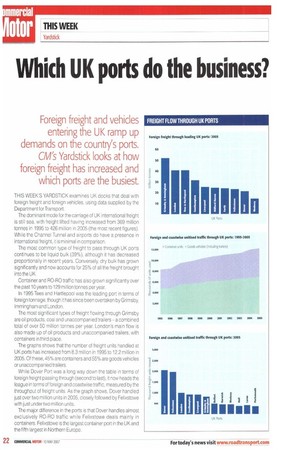Which UK ports do the business?
Page 22

If you've noticed an error in this article please click here to report it so we can fix it.
Foreign freight and vehicles entering the UK ramp up demands on the country's ports.
CM'S Yardstick looks at how foreign freight has increased and which ports are the busiest.
THIS WEEK'S YARDSTICK examines UK docks that deal with foreign freight and foreign vehicles, using data supplied by the Department for Transport.
The dominant mode for the carriage of UK international freight is still sea, with freight lifted having increased from 369 million tonnes in 1995 to 426 million in 2005 (the most recent figures) While the Channel Tunnel and airports do have a presence in international freight, it is minimal in comparison.
The most common type of freight to pass through UK ports continues to be liquid bulk (39%), although it has decreased proportionally in recent years. Conversely, dry bulk has grown significantly and now accounts for 25% of all the freight brought into the UK, Container and RO-RO traffic has also grown significantly over the past 10 years to 129 million tonnes per year.
In 1995 Tees and Hartlepool was the leading port In terms of foreign tonnage, though it has since been overtaken by Grimsby, Immingham and London.
The most significant types of freight flowing through Grimsby are oil products, coal and unaccompanied trailers — a combined total of over 50 million tonnes per year. London's main flow is also made up of oil products and unaccompanied trailers, with containers in third place.
The graphs shows that the number of freight units handled at UK ports has increased from 8.3 million in 1995 to 12.2 million in 2005. Of these, 45% are containers and 55% are goods vehicles or unaccompanied trailers, While Dover Port was a long way down the table in terms of foreign freight passing through (second to last), it now heads the league in terms of foreign and coastwise traffic, measured by the throughput of freight units. As the graph shows, Dover handled just over two million units in 2005, closely followed by Felixstowe with just under two million units.
The major difference in the ports is that Dover handles almost exclusively RO-RO traffic while Felixstowe deals mainly in containers. Felixstowe is the largest container port in the UK and the fifth largest in Northern Europe.






















































































































































































